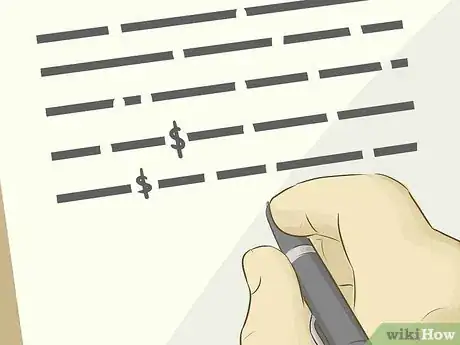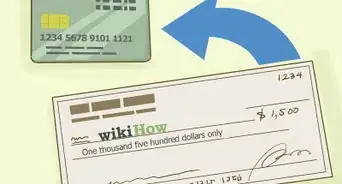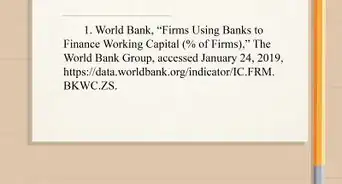This article was co-authored by Michael R. Lewis. Michael R. Lewis is a retired corporate executive, entrepreneur, and investment advisor in Texas. He has over 40 years of experience in business and finance, including as a Vice President for Blue Cross Blue Shield of Texas. He has a BBA in Industrial Management from the University of Texas at Austin.
There are 8 references cited in this article, which can be found at the bottom of the page.
This article has been viewed 16,437 times.
Banks may charge their customers fees for a number of reasons, including for an overdraft, a stop payment on a check, or a fee for maintaining the account. If you notice a fee on your bank statement that you have not seen in the past and you did not agree to, you should contact your bank immediately. Even if the fee was a penalty for a mistake that you made, banks are often willing to waive the fee or credit back your account rather than risk losing a loyal customer.
Steps
Determining Whether You Have Been Penalized
-
1Review your bank statements regularly. In some cases, your only notification of a fee charged to your bank account will be the deduction from your account that is reflected on your bank statement. It is very important that you regularly review all of the deductions made from your account, not just your account balance. If you were charged a fee, you will want to contact your bank as soon as possible to address the issue.
-
2Examine your terms of service. Whenever you sign up for a bank account or a credit card, you will be given a terms of service (TOS) to review. This document provides important information about your account and will describe any services that the bank will provide you and any fees or penalties that you may be charged. If you misplaced or can no longer find your terms of service, you can usually access them online on your bank’s website or you can request a copy in person at a local branch. When evaluating whether you have been mistakenly charged a bank fee, you want to review your terms of service for the following:
- Are you required to maintain a minimum deposit? Some banks offer “free accounts” so long as you maintain a minimum monthly amount in your accounts. If you fail to maintain that minimum monthly deposit, your bank may charge you a monthly service fee for the account.
- Are there any limits on withdrawals? This information should be contained in your TOS. Banks may charge you a penalty if you exceed the number of allotted withdrawals.
- Are you charged a fee for writing checks? Some banks only allow its customers to write a certain number of checks before incurring a penalty.
- Are you charged a fee when you use your debit card?
- Are you charged regular account fees? Some banks charge their customers monthly or yearly fees for maintenance or other account related services. You want to review your TOS to understand under what circumstances you can be charged a fee.
Advertisement -
3Determine what type of penalty you have been charged. Once you identified that a fee was debited from your account, you want to determine what type of fee that you were charged so that you can discuss it with the bank and try to have the fee waived. Generally, a bank customer may see the following types of fees charged to their account:
- An annual fee that is charged for you to maintain the account.
- A penalty for failing to keep a minimum balance in the account.
- A penalty fee for overdrawing your account (attempting to withdraw more money than you have in your account at a particular time).
- A late payment fee.
- A penalty fee for stopping payment on a check.[1]
-
4Check whether you opted in for overdraft protection. Some banks provide overdraft protection, which means that if you write a check or pay for something with your account and it costs more than you have in your bank account, the bank will pay the charge by either taking the money from your savings account or from a line of credit. Every time that the bank uses the “protection” you are charged a fee per transaction that overdrew your account. Legally, you must consent to be part of an overdraft program.
- Because of banking abuses regarding overdraft protection, Congress passed a law that requires all bank customers to “opt-in” for overdraft protection, which means that the bank can’t sign you up without your knowledge.
- Before challenging an overdraft fee, you should determine whether you consented to overdraft protection.
- If you can not recall signing up for the program, call your bank and ask them to provide you evidence that you signed up for the program.
- Even if you consented to overdraft protection, you can still challenge a fee and seek to have the fee waived.[2]
-
5Ascertain whether the fee was your fault. Before you begin negotiating with your bank to remove a fee, it is important that you determine whether you made a mistake. It could be that you didn’t read your new terms of service, or a check that you had written a long time ago came out unexpectedly. If the mistake was yours, you may need to take a different tact than if the bank made the error.
- With a bank error, you can demand an immediate correction to the problem and even express outrage and the bank’s incompetence. However, unpleasantness will rarely help you get your way, as most of the people you'll be talking to have no authority to correct the error.
- If you made an error that led to a fee, you are requesting that the bank do you a favor based on your banking history, your relationship with the bank, or any other argument that can help you demonstrate that this was a simple mistake.
Negotiating With Your Bank to Remove a Fee
-
1Address the fee immediately. Once you notice a fee on your account, you want to address it as soon as possible. You should review your TOS, determine the type of fee, and pull together any notes or information that you have regarding your account so that you are prepared to talk to a bank representative. You should pull the information together quickly and even if you don’t have all of the information, you should still contact your bank. Generally, it is easier to have a fee removed if you address it as soon as possible.[3]
-
2Call your bank. The best first step to take in negotiating with your bank is to speak with an actual person. Generally, this will get you the quickest response and requires the least amount of effort on your part. You want to speak with a customer service representative. You can usually find the phone number for your bank on the back of your ATM or debit card or on the bank’s website.[4]
-
3Be polite to the bank’s employees. While you may feel frustrated or even angry about the charge on your account, you should not take this frustration out on the customer service representative. By being polite, the person on the phone assisting you may be more inclined to help waive the fee. Politely explain why you are calling and state that you are seeking their assistance in addressing a fee charged on your account. Even if initially the employee states that they cannot help you, you should politely persist and ask them to review the fee.[5]
- If the bank made an error, they are generally going to be more inclined to quickly resolve the mistake.
- If a fee was charged because of an error that you made, you may need to convince the customer service representative to help you.
- For example, you can say “I understand that fees are charged for a reason but I am requesting that the bank do me a courtesy and waive this fee. I am a loyal banking customer and I would like to be able to continue our banking relationship. I would appreciate your assistance in waiving this fee.”
-
4Request that the bank waive your fee. You want to be polite but clear in requesting that the bank waive the fee. As mentioned above, a bank employee may at first state that he or she is unable to help you by removing your fees. In such cases, the customer should respectfully ask to speak to a supervisor with the authority to take the requested action. While you should still proceed in a polite manner, you should also set forth the reasons that the bank should remove your fees. Banks do not want to lose a valuable customer over a fee dispute, particularly if the fee is not significant. When explaining why you think the bank should remove the fee, consider the following arguments:
- If this is the first time that you overdrew your account, you should state “This is the first time that I have overdrawn my account and I would hope that the bank would make an allowance for a one time mistake.” A bank may be willing to help a customer if this is the first time that they were penalized.
- When asking that a fee be removed, you can admit that you made a mistake. For example, if you forgot to record a check that you had written and then did not have sufficient funds to cover the check, you could explain “This has never happened to me before but I somehow forgot to record the check and I was not expecting the money to come out of my account or I would not have written any additional checks.”
- By showing that your conduct was accidental, the bank may be more inclined to help you.
-
5Discuss your longstanding relationship with the bank, if applicable. If the bank employee appears unmoved by your specific arguments about why the fee should be removed, you should make a broader argument about your loyalty to the bank. If you are a longstanding customer, you can argue that the bank should remove the fee as a courtesy to you. Banks do not want to lose their longstanding customers over a fee dispute. You can use this to your advantage.
- You can say to the bank employee, “I have been a loyal customer for a number of years and I would hope that the bank would want to assist a customer who has never really had any issues before this moment.”
- If the employee fails to help you, you can always state that you think it may be time to transfer to another bank if this is how your current bank wants to treat you.
- While these arguments may not work, many banks will waive a fee to keep a good customer.[6]
-
6Ask to speak with a supervisor. If the customer service representative refuses to waive the fee, you should politely ask to speak with a supervisor with the authority to help you. It may be that the representative doesn’t have the authority to waive the fee or he or she feels that they have waived too many fees recently. Once it is clear that the person is not going to assist you, it is time to ask for a supervisor and go through your arguments again.
-
7Consider visiting your local branch. If speaking to a customer service representative and his or her supervisor doesn’t help, you should consider visiting your local branch and meeting with a bank employee face-to-face. It is more difficult to turn someone’s request down when they are sitting in front of you. You should explain what happened and ask that the fee be removed. If the fee was for failing to keep a minimum balance or other penalty, you can discuss other banking options that may help eliminate potential fees in the future.[7]
Filing a Complaint With Federal Regulatory Agency
-
1Consider filing a complaint against your bank. If you feel that you bank has been unfair or misleading, discriminated against you during the lending process, or violated a federal consumer protection law, you can file a complaint against the bank. If you are concerned that you may have been charged an excessive and illegal overdraft charge or other illegal fee, it is important to raise that concern with your bank and if they fail to act, take steps to report the bank’s conduct.
- You can view a state-by-state legal guide to credit and debit surcharges at: http://www.ncsl.org/research/financial-services-and-commerce/credit-or-debit-card-surcharges-statutes.aspx.
- Federal law prohibits banks from charging customers overdraft fees unless a customer has agreed to the overdraft service. If you did not agree to this service, you should report your bank.[8]
-
2Determine where to file your complaint. Depending on how your bank was chartered, you can file a complaint at one of several government agencies. The first step is to determine at which agency you should file your complaint. You can do this by using the Federal Reserve System's financial institution search tool located at: http://www.ffiec.gov/nicpubweb/nicweb/SearchForm.aspx.
- If you want to file a complaint against a national bank, banks that have the letters “N.A” after their name, or federal savings and loans, or federal banks, you should file your complaint with Office of the Comptroller of the Currency.
- The Federal Deposit Insurance Corporation (FDIC) handles complaints against state-chartered banks.
- The National Credit Union Administration handles complaints about federally charted credit unions.
- If you are unsure where to file your complaint, check with the Consumer Financial Protection Bureau (CFBP). The CFBP investigates complaints about a wide array of financial services including student loans, mortgages, credit cards, banking, and debt collection. You can file a complaint with the CFBP at: http://www.consumerfinance.gov/complaint/.
-
3Include all relevant information in your complaint. Each agency has its own website where you can submit complaints. It is important that you provide all of the information requested by that agency. Generally, your complaint should include the following:
- Your complete name and mailing address, which should match your bank’s records.
- The best telephone number at which to reach you and your email address.
- If applicable, the name of your attorney or other designated representative with whom you want the agency to discuss your complaint.
- The name and address of your financial institution.
- The type of account that you hold at the financial institution.
- The name of any person(s) at the bank with whom you have been in contact.
- State whether the bank has responded to your complaint.
- A clear and detailed explanation of your complaint.[9]
-
4Wait for a response. Generally, once you have submitted your complaint, the agency will contact the bank in question and attempt to get a response to your allegations and additional information. The bank usually has a certain amount of time to respond. For example, CFBP gives banks 15 days to respond and expects a bank to close almost all complaints within 60 days. While filing a complaint cannot guarantee that certain charges will be credited back to your account, involving a government agency dedicated to protecting consumer’s rights should increase your chances of getting the matter resolved.
- Generally, once the bank responds to the complaint, the government agency will allow you to view the response.[10]
- If you still feel that you have suffered damages as a result of the bank’s illegal activity, you could consider hiring an attorney to file a lawsuit against the bank. Typically, however, the damages in question do not warrant an individual lawsuit.
- If the bank’s illegal behavior impacted a number of customers, some attorneys file lawsuits on behalf of the entire group (called a class action).
- You can conduct an internet search to see whether there are any pending class action lawsuits against your bank for the same reasons that you filed your complaint. If so, you can contact the attorney on the case and discuss joining the lawsuit.
References
- ↑ http://business.time.com/2013/08/23/want-to-get-bank-fees-waived-complain/
- ↑ http://money.cnn.com/2015/05/12/pf/overdraft-fees/
- ↑ http://business.time.com/2013/08/23/want-to-get-bank-fees-waived-complain/
- ↑ http://business.time.com/2013/08/23/want-to-get-bank-fees-waived-complain/
- ↑ http://www.mymoneyblog.com/bank-of-america-overdraft-fee-refund.html
- ↑ http://www.gobankingrates.com/checking-accounts/how-never-pay-another-bank-overdraft-fee-again/; http://business.time.com/2013/08/23/want-to-get-bank-fees-waived-complain/
- ↑ http://www.mymoneyblog.com/bank-of-america-overdraft-fee-refund.html
- ↑ http://www.nytimes.com/2015/04/29/your-money/regions-bank-fined-7-5-million-for-illegal-overdraft-charges.html?_r=0
- ↑ http://www.helpwithmybank.gov/complaints/your-letter/complaints-your-letter.html






































































